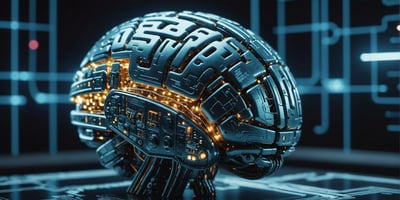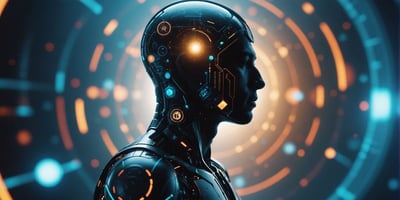Imagine a world where you could live forever, not in a physical body, but as a digital version of...
The Future of Digital Immortality: What Lies Ahead
The idea of digital immortality is no longer just science fiction. With rapid advances in technology, we are closer than ever to preserving human consciousness in a digital form. This article explores what digital immortality means, the science behind it, the challenges we face, and what the future might hold.
Key Takeaways
- Digital immortality aims to preserve human consciousness in a digital form.
- Technological advances in AI and neuroscience are crucial for achieving digital immortality.
- There are many challenges, including technical, ethical, and legal issues.
- The digital afterlife industry is growing, with companies offering various services.
- Public opinion is divided, with some embracing the idea and others skeptical.
Understanding Digital Immortality
What is Digital Immortality?
Digital immortality technology aims to preserve a person’s mind and consciousness in a digital format. This means that even after someone passes away, their thoughts, memories, and personality could live on in a computer or virtual world. Imagine being able to talk to a digital version of a loved one who has passed away. This concept is both exciting and a bit scary, as it challenges our traditional views on life and death.
Historical Context and Evolution
The idea of digital immortality isn’t new. People have always dreamed of living forever, and now technology is making it seem possible. Over the years, we’ve seen advancements in computing power and artificial intelligence that bring us closer to this goal. From early science fiction stories to today’s cutting-edge research, the journey of digital immortality has been fascinating.
Key Players in the Field
Several companies and researchers are leading the way in digital immortality technology. These pioneers are working on ways to upload human minds to computers and create digital afterlives. Some of the key players include tech giants and innovative startups, all racing to make digital immortality a reality.
The idea of “digital immortality” would have its upsides; we could preserve the minds of modern geniuses and have their guidance through future conflicts.
In summary, understanding digital immortality involves exploring what it is, its historical roots, and the key players driving this revolutionary field forward.
The Science Behind Digital Immortality
Technological Foundations
Digital immortality relies on advanced technologies to create and maintain virtual versions of ourselves. These technologies include powerful computers, vast storage systems, and sophisticated software. Without these man-made electronic devices, digital immortality wouldn’t be possible.
Role of Artificial Intelligence
AI plays a crucial role in digital immortality. It helps in creating lifelike simulations and interactions. AI can analyze vast amounts of data to recreate a person’s personality, habits, and even their voice. This is how AI is bringing back the dead in a new form.
Neuroscience and Brain Mapping
Understanding the human brain is key to digital immortality. Scientists use brain mapping techniques to study how our brains work. This information is then used to create digital replicas of our minds. Brain mapping is a complex process, but it’s essential for achieving digital immortality.
The journey to digital immortality is a blend of cutting-edge technology and deep scientific understanding. It’s a fascinating field that combines the best of both worlds.
Challenges on the Path to Digital Immortality
Navigating the path to digital immortality is an awe-inspiring and mind-bending journey that requires a willingness to embrace change and challenge the status quo. We’ll explore five challenges that seekers of digital immortality must navigate.
The Digital Afterlife Industry
Leading Companies
The digital afterlife industry is rapidly evolving. Several companies promise to create virtual reconstructions of dead individuals based on their digital footprints. These companies use advanced technologies to offer services that were once considered science fiction. One key player in this field is Eternime, which aims to preserve a person’s thoughts and memories for future generations. Another notable company is Replika, which creates AI-driven chatbots that mimic the personality of the deceased.
Services Offered
The services offered in the digital afterlife industry are diverse. They range from creating digital replicas for business purposes to preserving personal memories. Some companies focus on AI knowledge management systems that help in maintaining a person’s digital presence. Others offer more personalized services, like creating virtual memorials or interactive avatars that can communicate with the living.
Market Growth and Trends
The market for digital afterlife services is growing rapidly. As technology advances, more people are becoming interested in preserving their digital selves. This has led to a surge in demand for services that offer digital immortality. The industry is expected to grow significantly in the coming years, with new players entering the market and existing companies expanding their offerings.
The digital afterlife industry is not just about preserving memories; it’s about creating a lasting legacy. As more people embrace this concept, the industry will continue to evolve and expand.
Challenges on the Path to Digital Immortality
We’ll explore five challenges that seekers of digital immortality must navigate. The question isn’t just whether we can create digital replicas, but how we can ensure they are accurate and meaningful. The theory that humans can be digitized and live on within the digital confines of a computer-based existence has been the subject of debate. While digital immortality sparks our imaginations, it is the concept of singularity that provides the foundation for transhumanist ambitions.
Debates and Controversies
Skepticism and Criticism
The theory that humans can be digitized and live on within the digital confines of a computer-based existence has been the subject of debate. Critics argue that the technology is still far from being able to replicate the complexity of the human mind. Some believe it’s an impossible dream. Others worry about the potential misuse of such technology.
Philosophical Questions
Digital immortality raises many philosophical questions. What does it mean to be human if our consciousness can be uploaded to a machine? Is a digital copy of a person truly the same as the original? These questions challenge our understanding of identity and existence.
Public Perception
Public perception of digital immortality is mixed. While some people are excited about the possibilities, others are fearful or skeptical. The idea of living forever in a digital form can be both fascinating and terrifying. Knowledge sharing about the benefits and risks is crucial to shaping public opinion.
The future of digital immortality is uncertain, and it will likely continue to be a topic of intense debate and discussion.
The Role of Singularity in Digital Immortality
What is the Singularity?
The singularity is a point in the future where technology grows so advanced that it changes life as we know it. Futurist Raymond Kurzweil sees nanorobots as the key to extending human lifespans, potentially leading to plausible immortality and a future of singularity. This concept is the foundation for many transhumanist ambitions.
Transhumanist Ambitions
Transhumanists believe that we can use technology to enhance human abilities and even achieve immortality. They see the singularity as a crucial step toward this goal. The idea is that once we reach the singularity, we can merge with machines and live forever in a digital form.
Potential Impact on Society
If we achieve digital immortality through the singularity, it could change everything. Imagine a world where people can live forever in a digital form. This could solve many problems, like aging and disease, but it could also create new challenges. For example, what happens to our sense of identity and what does it mean to be human? These are questions we will need to answer as we move closer to this future.
Cultural and Religious Perspectives
Historical Quest for Immortality
The quest for immortality has been a fixture of human culture and imagination for millennia. From ancient myths to modern science fiction, humans have always dreamed of living forever. Many religions promise a form of eternal life or an afterlife, reflecting our deep-seated desire to transcend death. This age-old aspiration is now taking a new form with digital immortality, where technology aims to preserve our consciousness forever.
Religious Views
Different religions have varied perspectives on digital immortality. Some see it as a natural extension of their beliefs in an afterlife, while others view it with skepticism. For instance, some Christian denominations might question whether a digital copy of a person truly possesses a soul. On the other hand, certain Eastern philosophies might be more open to the idea, seeing it as a continuation of the cycle of life and rebirth. Understanding these diverse viewpoints is crucial as we navigate the ethical and spiritual implications of digital immortality.
Cultural Narratives
Cultural narratives around death and immortality are also evolving. In many cultures, family archiving and care for the dead are directly related to dreams of radical life extension and digitally-afforded immortality. Stories and traditions that once focused on the afterlife are now being reimagined in the context of digital preservation. This shift is not just about technology but also about how we perceive our existence and legacy in a digital age.
As we move forward, it’s essential to consider how these cultural and religious perspectives will shape the future of digital immortality. They will influence not only the acceptance of this technology but also its development and implementation.
Imagining a World with Digital Immortality
Imagine a world where death is no longer an inevitability, and immortality is within our grasp. The concept of digital immortality proposes that we could live on within the digital confines of a computer-based existence. This idea sparks our imaginations and raises many questions about what daily life would look like in such a world.
Daily Life in a Digitally Immortal World
In a world with digital immortality, our daily routines would change dramatically. People could interact with digital versions of their loved ones, who have passed away. These digital beings would retain the memories and personalities of the deceased, making conversations feel real and comforting. Imagine never having to say goodbye.
Social and Economic Implications
The social and economic landscape would also shift. With digital immortality, the workforce might see a mix of human and digital employees. This could lead to new job opportunities and industries focused on maintaining and upgrading digital lives. However, it might also create economic divides between those who can afford digital immortality and those who cannot.
Potential Benefits and Drawbacks
There are many potential benefits to digital immortality. It could offer a way to preserve knowledge and wisdom for future generations. People could continue to contribute to society long after their physical bodies have perished. On the flip side, there are drawbacks to consider. The idea of living forever in a digital form might not appeal to everyone. Some might find it unnatural or even unsettling.
The promise of digital immortality is both exciting and daunting. It challenges our understanding of life and death, and forces us to rethink what it means to be human.
Future Predictions and Speculations
Expert Opinions
Experts have a lot to say about digital immortality. Some believe that within six years, AI will help humanity reach longevity escape velocity and achieve biological immortality. This means we could live forever, thanks to technology. Others are more skeptical, thinking it might take much longer or may never happen at all.
Possible Timelines
Predicting the exact timeline for digital immortality is tricky. Some futurists are optimistic, suggesting we could see major breakthroughs by 2030. Others argue that we are still decades away from any significant progress. The timeline largely depends on advancements in AI, neuroscience, and other technologies.
What Lies Ahead
Looking ahead, the future of digital immortality is both exciting and uncertain. AI will play a crucial role in helping us achieve this dream. However, there are many challenges to overcome, including technical, ethical, and legal issues. If we can navigate these hurdles, the possibilities are endless. Imagine a world where you can live forever, free from the limitations of a biological body.
The journey to digital immortality is filled with both hope and uncertainty. While the dream is grand, the path is fraught with challenges that we must overcome to make it a reality.
Conclusion
As we look ahead, the idea of digital immortality is both exciting and full of challenges. While some companies are making strides in creating digital versions of people, the journey is far from over. The concept of living forever through technology raises many questions, from ethical concerns to technical hurdles. But one thing is clear: the dream of digital immortality continues to capture our imagination. Whether or not it becomes a reality, it pushes us to think about what it means to live and what it means to be human. So, as technology advances, we’ll keep exploring and debating, always curious about what the future holds.


